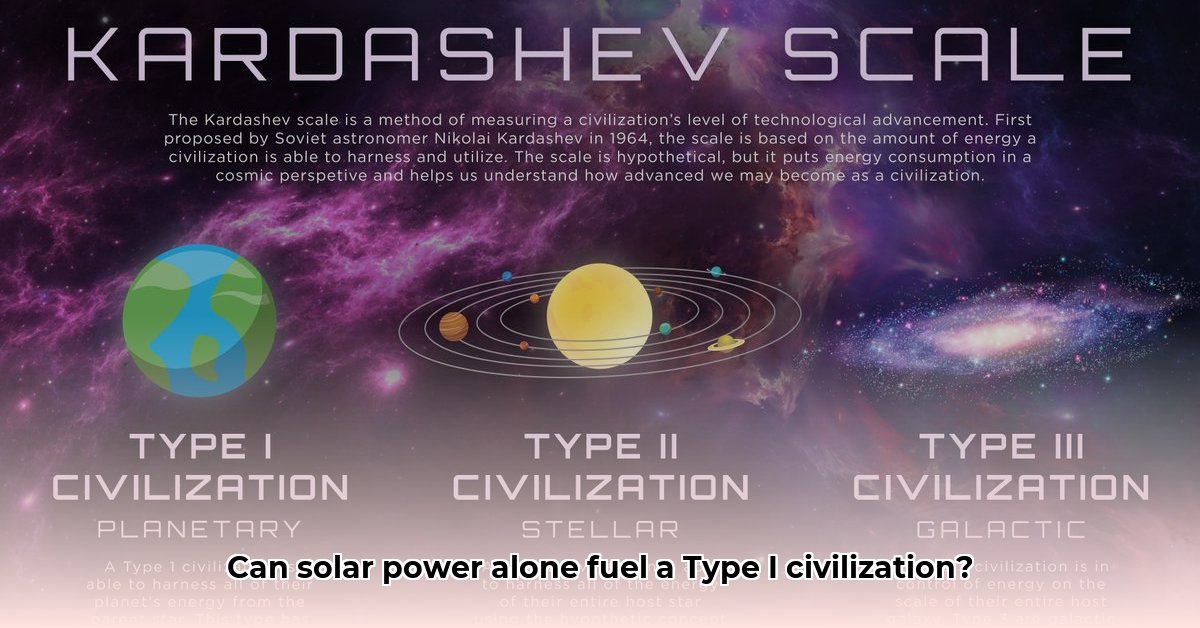Humanity’s quest for energy has driven us from the first flickering flames to the complex power grids of today. But what if the ultimate energy source isn’t hidden deep within the Earth, but shining down on us every day? Elon Musk, the visionary behind Tesla and SpaceX, suggests that solar power could be our key to reaching Type I civilization status – a milestone on the Kardashev Scale signifying complete mastery of a planet’s energy. This article explores this audacious idea, examining the potential of solar energy, the challenges we face, and the implications for humanity’s future.
Harnessing the Sun: A Path to Type I?
The Kardashev Scale: A Cosmic Yardstick
The Kardashev Scale, a concept developed by Soviet astronomer Nikolai Kardashev, categorizes civilizations based on their energy consumption. A Type I civilization wields the total energy of its home planet, a Type II civilization commands the energy of its star, and a Type III civilization controls the energy of its entire galaxy. Currently, humanity sits at approximately a 0.73 on this scale, relying heavily on finite, polluting fossil fuels. Musk’s vision suggests that solar energy could be the bridge to becoming a Type I civilization, harnessing the immense power of our sun to meet our growing energy needs.
The Sun’s Bounty: A Nearly Limitless Resource
Our sun bathes Earth in approximately 174 petawatts (1.74 x 10^17 watts) of energy. Just one square mile of sunlit land receives around 2.5 gigawatts of solar power, translating to roughly 3 gigawatt-hours of usable energy daily with current technology. Musk emphasizes this abundance, suggesting that even a small fraction of this energy could power our entire civilization. This leads us to a critical question: Could focusing on solar power propel us to a Type I future?
Musk’s Solar Gambit: A Calculated Bet
Musk’s interest in solar energy isn’t merely theoretical; Tesla’s investments in solar technology and energy storage demonstrate his commitment. He envisions a future where solar energy takes center stage, arguing that harnessing even a fraction of the sun’s potential could dramatically alter our trajectory on the Kardashev Scale. Is this a realistic ambition, or just a far-off dream?
The Path to a Solar-Powered Civilization: Challenges and Opportunities
Technological Leaps and Bounds
Transitioning to a primarily solar-powered civilization requires overcoming significant technological hurdles. We need to develop solar panels with dramatically increased efficiency, capable of capturing a larger percentage of incoming sunlight. Equally important is the development of advanced energy storage solutions to address the intermittent nature of solar power. Imagine batteries far beyond our current capabilities, storing vast amounts of energy for use during the night or on cloudy days. Furthermore, a smart global energy grid is essential to efficiently distribute this clean energy worldwide. Space-based solar power, though still in its early stages, offers an intriguing possibility – capturing sunlight in space and beaming it down to Earth. This concept, while promising, requires significant technological advancement and investment.
Logistical and Economic Landscapes
The shift to a solar-dominated energy system presents enormous logistical challenges. Constructing massive solar farms, upgrading existing energy infrastructure, and creating a smart global grid require substantial financial investment and international cooperation. Managing the economic transition away from fossil fuels, including job displacement and the creation of new industries, will require careful planning. The economic viability of space-based solar power remains a topic of debate, with the potential for high upfront costs and long-term benefits.
Social and Political Dimensions
Reaching Type I status isn’t solely a technological endeavor; it requires global cooperation and a shift in societal attitudes. International agreements on resource allocation, land use for solar farms, and equitable energy distribution are crucial. Public acceptance of large-scale solar projects and the potential environmental impacts must be addressed through education and transparent dialogue. Political factors, including regulatory frameworks and government incentives, will play a significant role in accelerating the adoption of solar technologies.
Environmental Considerations
While solar energy is considered a clean energy source, it’s not without environmental impacts. The manufacturing of solar panels requires resources and generates some waste. Large-scale solar farms can alter land use and potentially affect local ecosystems. Space-based solar power, while promising, introduces the risk of space debris and the environmental effects of transmitting energy to Earth. Careful research and mitigation strategies are essential to minimize these impacts.
Beyond Type I: A Glimpse into the Future
Achieving Type I status through solar energy is not an end goal, but a stepping stone. It represents a fundamental shift in our relationship with energy, paving the way for further advancements and exploration. With nearly limitless clean energy, humanity could dedicate more resources to scientific research, technological development, and space exploration. Perhaps even the ambitious dreams of Type II and Type III civilizations, harnessing the power of stars and galaxies, could one day become reality.
Conclusion
The journey to a Type I civilization powered by solar energy is a daunting but inspiring endeavor. It demands scientific breakthroughs, technological innovation, international collaboration, and a shared vision for a sustainable future. While challenges remain, the potential rewards – a clean energy future, a healthier planet, and the possibility of unlocking humanity’s full potential – make this a quest worth pursuing. As we continue to explore the vast potential of our nearest star, we take the first steps toward a future limited only by our imagination and our collective will.
- What Types Of Jobs Does Wind Energy Create? - November 23, 2025
- Residential Wind Energy: Powering Homes with Small Turbines - November 21, 2025
- How Did Charles F. Brush Discover Wind Energy Tech? - November 19, 2025
















